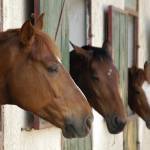A Healthy Home Life: Clean, Airy Stalls Advantageous for Horses

Horses are stabled for a variety of reasons. Injured or sick horses are often confined while they mend or recuperate. Quarantine regulations, either to prevent the spread of disease or as part of importation and exportation requirements, sometimes dictate that horses be housed for long stretches. In recent years, the dwindling number of acres dedicated to horse production has drastically altered traditional, free-roaming management systems such that horses are spending more time in stalls than ever before.
Show horses spend much of their lives in the calm and usually comfortable surroundings of spacious stalls. While such a management system reduces the risks of blemishes that are almost inescapable in turnout situations and ensures a rich, flawless coat necessary for the show ring, continual stalling has its downsides. One possible disadvantage, even danger, is exposure to aerial ammonia.
The short-term athletic ability and long-term welfare of horses are largely dependent on respiratory health and well-being. Although high levels of ammonia may not directly cause respiratory disease, sustained exposure to the irritant may weaken the defense mechanisms of the lungs, giving pathogens such as bacteria and viruses the opportunity to take hold and flourish.
From Feedstuffs to Stall Floor
The chief waste product of protein digestion is urea, the majority of which is excreted from the horse in urine. The concentration of urea in urine is largely relative to the amount of protein being consumed by the horse. As more protein is digested, levels of urea voided in the urine escalate. Evacuation of urea from the body is imperative. Any condition that impairs this elimination can lead to uremia, a potentially fatal buildup of urea and other nitrogen wastes in the blood.
Once released by the horse in its urine, urea is employed by certain bacteria as a source of energy. A product of this secondhand usage by bacteria is ammonia, which yields the familiar pungent smell. Tightly closed, heated barns, like those that house show horses, or poorly ventilated stables are frequently rife with ammonia fumes.
Because ammonia lingers near the stall floor, specific attention must be given to stalls inhabited by foals, weanlings, and yearlings. Young horses spend much of their time lying down and therefore could be subjected to more concentrated levels of ammonia. In one research study, ammonia levels as high as 400 ppm (parts per million) were measured in foaling stalls. Levels of more than 10 ppm may be detrimental to horses.
A positive relationship also exists between protein ingestion and water intake. Increased levels of protein in the diet trigger a thirst response, and horses will drink significantly more water when overfed protein than when offered appropriate levels of the nutrient. One undeniable effect of increased water intake is a rise in urine output. Superfluous protein is usually afforded by the feeding of legume hays, namely alfalfa. Legume hays contain significantly more protein than grass hays of similar quality.
Alfalfa hay generally has 11-20% protein, while grass hays usually contain 6-10%. Though alfalfa is appropriate for some classes of horses, particularly those with above-average energy requirements, most adult horses fare well on grass hay or legume/grass mixed hay. In some areas of the United States, such as the West, alfalfa hay is more plentiful and less expensive than grass hay, and therefore used more extensively in horse operations. In these instances, horsemen should be mindful of the protein content in the concentrate. As more alfalfa is fed, a concentrate with less protein can be provided.
Aside from the obvious stable-keeping aggravations of feeding surplus protein, overfeeding protein is costly, as protein-rich feedstuffs are typically more expensive than nonproteinaceous ingredients. A ration evaluation by an equine nutritionist can determine whether or not a ration is supplying superabundant protein. By correcting dietary protein excesses, urea concentration in the urine will be kept to a minimum and aerial ammonia will decrease.
Keeping Ammonia at Bay
Stall maintenance becomes a paramount concern when horses are stall-bound. Removal of all waste and soiled bedding is an obvious must-do. Bedding type does not seem to affect ammonia levels. A study conducted at the University of Illinois found no appreciable differences in levels when four bedding materials—straw, sawdust, sand, and shredded newspaper—were used. While bedding type proved to have little to do with ammonia levels, bedding depth may. If the bedding is deep enough that the urine soaks through to the floor without appreciable accumulation on the surface, ammonia odor will be diminished. If a scant amount of bedding is used, obvious wet spots or, in worst-case scenarios, pools of urine are likely and aerial ammonia will be profound.
The use of certain substances such as zeolite, hydrated lime, or sodium bisulfate reduces the level of ammonia in stalls by absorbing moisture from the stall floor and neutralizing foul odors. A research study performed at the University of Kentucky found that zeolite was effective in lowering ammonia levels at the stall floor. One aspect of this trial involved the use of endoscopic evaluation to determine the well-being of respiratory tissues. Seventy-five percent of the horses housed in stalls not treated with the ammonia-absorbing compound showed pharyngeal inflammation on endoscopic examination, compared to only 25% of those housed in treated stalls.
In addition to astute stable-keeping, atmospheric ammonia levels can be diluted by appropriate ventilation. Properly situated and adequately sized wall and roof vents are necessary to make full use of natural ventilation forces. In barns that are particularly long or wide, powerful, industrial-strength fans may aid ventilation efforts.
Curtailing ammonia buildup in stables is achieved by offering well-balanced rations that contain enough protein for optimal growth or performance without surplus, by cleaning stalls fastidiously, and by ensuring well-ventilated housing for stalled horses. Reducing aerial ammonia will promote long-term respiratory health and provide yet another step in ensuring that equine athletes lead long, productive careers.








